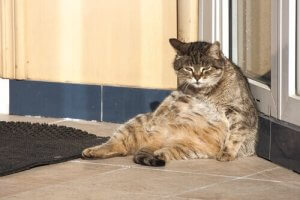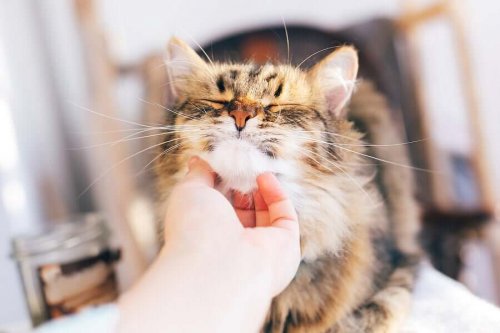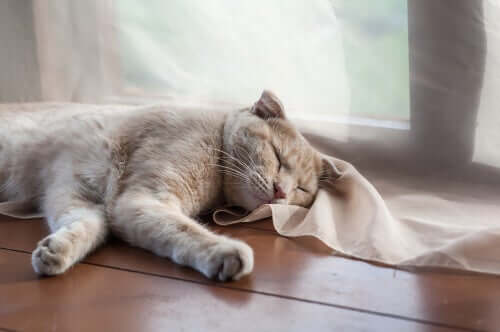A Day in the Life of Your Cat - What's It Like?

A day in the life of your cat will vary slightly from one breed to another. It’ll also depend on whether your one is an indoor animal or an outdoor feline, capable of hunting and feeding themselves.
In any case, there are some similarities in this species’ daily activities that make their daily adventures special.
As you know, cats are intelligent and curious animals who need daily opportunities for exercise, stimulation, and companionship. Cats love to spend quality time with their owners. This quality time makes them feel important and loved. All they need is to sit on your lap while you watch television. And, of course, if you add petting and brushing to the deal then they’ll be in heaven.
A day in the life of your cat
Here are the different activities that take place during a typical day in the life of a cat throughout a 24-hour period. We’ll start with the activity that occupies most of your cat’s time: sleeping. You may not know it, but adult cats can sleep an average of 16 hours per day.
Grooming is another common activity for a cat. They can spend about two or three hours licking every inch of their fur.
These animals are quite meticulous and like to be as clean as they can. This ritual also allows them to maintain their good health and also to get rid of any parasites they might have. They do so by distributing the sebum in their hair with every lick, making it waterproof.
In addition, the cat absorbs vitamin D as they lick their fur. This licking is a sort of meditation for the animal as it’s soothing and, therefore, good for their mental health.
Exploring and marking their territory

Now comes the action! Your cat probably spends part of their day marking their territory, usually to make sure it’s well-maintained. Did you know your feline is master of a kingdom? You can bet they chose one right after they arrived at your home.
They even have property “deeds” to prove it: their olfactory marks which come in the form of pheromones and urine and the scratches they leave where they roam around. This daily program, therefore, is to ensure that the different traces of their presence remain clear and also to explore any changes that may have occurred in their environment while they were away.
Watching the world go by
One of the activities cats enjoy the most is to simply contemplate their surroundings. Yours most likely spends a lot of time watching what happens around them. They may do so while sitting or lying down. But, for sure, their ears will be alert and their eyes wide open, as they carefully observe what goes in their immediate environment.
In order to get on with this activity, the animal usually chooses a place where they feel safe and where they can observe without being noticed. For example, from the balcony, the window sill, or the roof. Even a simple edge of a wall can be a fantastic watchtower from which to satisfy their endless curiosity.
Playing and chasing
Unlike their distant ancestors, domestic cats no longer need to spend long hours searching for food. However, their hunting and vigilant behavior remain deeply anchored in every inch of their being. These moments of daily relaxation remain essential for your feline.
Eating and doing their business
Of course, any activities having to do with physiological needs occupy a small part of a cat’s time and are evenly distributed throughout their day. When it comes to eating, cats mainly like to snack. That is, they prefer to eat smaller portions of food on a regular basis, instead of having two large meals per day.
The perfect schedule of a day in the life of your pet
- 7:00 am – 8:00 am. Waking up and eating a portion of canned food or fresh and dried food. Even better if there’s an open window or a door through they can look through and stimulate their senses. Note that there must be enough fresh drinking water.
So, remember to change the water in your cat’s bowl. Do so frequently and make sure it’s always full. Spend at least 10 minutes of quality time talking to them while making physical contact. This is the time to check if there’s anything unusual in their behavior, attitude, and fur. Pay attention to the appearance of their eyes and to anything else you may like to check up on.

- 9:00 am – 12:00 pm. It’s naptime! Well, unless you’re around. If so, then it’ll be time to follow you around while you do chores. However, if you’re away, it’ll be time for a nap for sure.
- 12:00 pm – 1:00 pm. Ideally, most cats would prefer to interact with you. They’ll take any chance they get to play and be stimulated. So, make sure they can access an interesting window, a high perch or even just some toys if you’re away from home most of the day.
And then …
- 1:00 pm – 5:00 pm. If you’re at home, this time is ideal to brush your cat as they peacefully rest on your lap.
- 5:00 pm – 7:30 pm. This is the time for drinks, dinner, and games! Again, change their water and then feed them. Control your cat’s appetite. Play with them longer than you do in the morning. Playing allows them to burn some of the accumulated energy they might have.
- 7:30 pm – 11:00 pm. The time to be with the family. If you didn’t spend your afternoon with your cat then this is a good opportunity to brush them and to enjoy each other’s company. Either that or just lounge on the couch together while you watch TV. You may also open a window or a door and allow your pet to enjoy the sounds and smells of the outdoor world.
We hope you’ve enjoyed this article, now you know what a day in the life of your pet is like!
A day in the life of your cat will vary slightly from one breed to another. It’ll also depend on whether your one is an indoor animal or an outdoor feline, capable of hunting and feeding themselves.
In any case, there are some similarities in this species’ daily activities that make their daily adventures special.
As you know, cats are intelligent and curious animals who need daily opportunities for exercise, stimulation, and companionship. Cats love to spend quality time with their owners. This quality time makes them feel important and loved. All they need is to sit on your lap while you watch television. And, of course, if you add petting and brushing to the deal then they’ll be in heaven.
A day in the life of your cat
Here are the different activities that take place during a typical day in the life of a cat throughout a 24-hour period. We’ll start with the activity that occupies most of your cat’s time: sleeping. You may not know it, but adult cats can sleep an average of 16 hours per day.
Grooming is another common activity for a cat. They can spend about two or three hours licking every inch of their fur.
These animals are quite meticulous and like to be as clean as they can. This ritual also allows them to maintain their good health and also to get rid of any parasites they might have. They do so by distributing the sebum in their hair with every lick, making it waterproof.
In addition, the cat absorbs vitamin D as they lick their fur. This licking is a sort of meditation for the animal as it’s soothing and, therefore, good for their mental health.
Exploring and marking their territory

Now comes the action! Your cat probably spends part of their day marking their territory, usually to make sure it’s well-maintained. Did you know your feline is master of a kingdom? You can bet they chose one right after they arrived at your home.
They even have property “deeds” to prove it: their olfactory marks which come in the form of pheromones and urine and the scratches they leave where they roam around. This daily program, therefore, is to ensure that the different traces of their presence remain clear and also to explore any changes that may have occurred in their environment while they were away.
Watching the world go by
One of the activities cats enjoy the most is to simply contemplate their surroundings. Yours most likely spends a lot of time watching what happens around them. They may do so while sitting or lying down. But, for sure, their ears will be alert and their eyes wide open, as they carefully observe what goes in their immediate environment.
In order to get on with this activity, the animal usually chooses a place where they feel safe and where they can observe without being noticed. For example, from the balcony, the window sill, or the roof. Even a simple edge of a wall can be a fantastic watchtower from which to satisfy their endless curiosity.
Playing and chasing
Unlike their distant ancestors, domestic cats no longer need to spend long hours searching for food. However, their hunting and vigilant behavior remain deeply anchored in every inch of their being. These moments of daily relaxation remain essential for your feline.
Eating and doing their business
Of course, any activities having to do with physiological needs occupy a small part of a cat’s time and are evenly distributed throughout their day. When it comes to eating, cats mainly like to snack. That is, they prefer to eat smaller portions of food on a regular basis, instead of having two large meals per day.
The perfect schedule of a day in the life of your pet
- 7:00 am – 8:00 am. Waking up and eating a portion of canned food or fresh and dried food. Even better if there’s an open window or a door through they can look through and stimulate their senses. Note that there must be enough fresh drinking water.
So, remember to change the water in your cat’s bowl. Do so frequently and make sure it’s always full. Spend at least 10 minutes of quality time talking to them while making physical contact. This is the time to check if there’s anything unusual in their behavior, attitude, and fur. Pay attention to the appearance of their eyes and to anything else you may like to check up on.

- 9:00 am – 12:00 pm. It’s naptime! Well, unless you’re around. If so, then it’ll be time to follow you around while you do chores. However, if you’re away, it’ll be time for a nap for sure.
- 12:00 pm – 1:00 pm. Ideally, most cats would prefer to interact with you. They’ll take any chance they get to play and be stimulated. So, make sure they can access an interesting window, a high perch or even just some toys if you’re away from home most of the day.
And then …
- 1:00 pm – 5:00 pm. If you’re at home, this time is ideal to brush your cat as they peacefully rest on your lap.
- 5:00 pm – 7:30 pm. This is the time for drinks, dinner, and games! Again, change their water and then feed them. Control your cat’s appetite. Play with them longer than you do in the morning. Playing allows them to burn some of the accumulated energy they might have.
- 7:30 pm – 11:00 pm. The time to be with the family. If you didn’t spend your afternoon with your cat then this is a good opportunity to brush them and to enjoy each other’s company. Either that or just lounge on the couch together while you watch TV. You may also open a window or a door and allow your pet to enjoy the sounds and smells of the outdoor world.
We hope you’ve enjoyed this article, now you know what a day in the life of your pet is like!
All cited sources were thoroughly reviewed by our team to ensure their quality, reliability, currency, and validity. The bibliography of this article was considered reliable and of academic or scientific accuracy.
- Enriching Your Cat´s Life (s.f.) En WedMD. Recuperado el 14 de Mayo de 2019 de https://pets.webmd.com/cats/enriching-your-cats-life#1
- 10 tips to keep your cat happy indoors (s.f.) En The Humane Society of the United States. Recuperado el 14 de Mayo de 2019 de https://www.humanesociety.org/resources/10-tips-keep-your-cat-happy-indoors
This text is provided for informational purposes only and does not replace consultation with a professional. If in doubt, consult your specialist.








